|
|
|
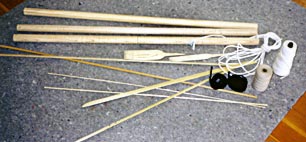
|
Loom Parts: Dowels of various widths, battens, weaving forks, worsted
wool warp yarn, string, cotton clothesline, dyed weft yarn
(here
black) doubled and respun for edging cords. |
|
|

|
|
Winding the Warp: The tightly spun white warp
yarn is wound in continuous
figure eights around two dowels presently
serving as warping frame. In weaving, these warps
will be completely covered by the
weft yarns. |
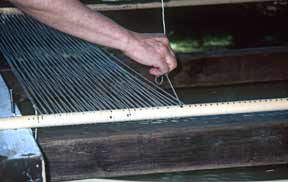
|
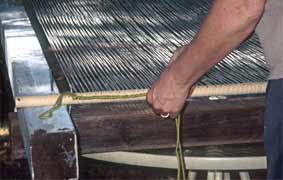
|
Twining
the End Cords: Weft yarn, doubled and
respun, is twined between the loops of warp to bind
them to each other and space them equally.
The warping beams will then be removed and lashed
on the outside of the twined warp ends,
becoming the loom beams for weaving. The end
cords will form the top and bottom selvages of
the finished weaving. |
|
|
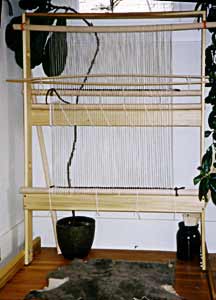
|
Dressing
the Loom (left): With
the loom beam lashed to a tensioning bar and tied to the loom, the
warp is pulled taut for weaving (right). The beat of the
weaving
fork packs down the wefts, strand by strand. Above the fork, the batten
holds open the current shed. At the top, a stationary stick holds every
other warp to the front; the warps below the stick can be pulled
forward for weaving
by use of the heddle stick with string heddles laced around
the
rear warps. |
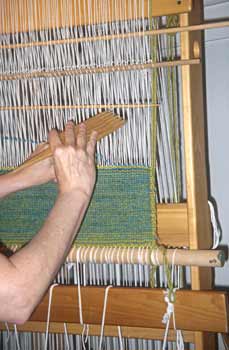
|
|
|
|
FOUR-SELVAGE WEAVING
More
than 1,200 years ago, archeologists tell us, the peoples of the
American
Southwest perfected the vertical frame loom, enabling the weaving of
pieces wider than the weaver's armreach with a backstrap loom. Setting up their looms in the
confined space of kivas, adapting to their needs and way of living the
continuous warp technology of the backstrap loom already in use in
Central and South America, these weavers wove in cotton and other
native plant fibers. This technology, together with the wool of sheep
introduced by the Spanish, was later adoped by Navajo weavers to great and
well-known advantage.
This is the loom and technology I use. For
warp, I use a tightly spun worsted wool. For each weaving, I wind the warp
as shown in the photographs, twine the end cords to bind and space the
warp loops, and finally lash the end cords to the
beams of the loom. In a sense, each rug or tapestry forms its own loom, and as a
result, each completed weaving comes off the loom frame
with finished selvages on all four
sides. As I weave, using various tapestry techniques, including those
of Navajo and kilim rugs, the warp is completely covered by the softer,
but very closely packed single-ply weft yarns, which give both tapestries and rugs their
thickness and supple resilience. I use modern "acid" dyes to dye or
paint wool and silk yarns, as these dyes offer the rich colors I delight in
as well as good washfastness and lightfastness and minimized
environmental impacts.
As
I weave, I often think how throughout human time-- 50,000 years or
more, up until a mere 300 or so years ago--all items of material
culture were made by hand, with the rhythm of work set not by machines
but by the breath and heartbeat of a human. In the case of textiles,
each fiber passed multiple times through human hands: in the
harvesting or shearing, the washing and preparation for spinning, the spinning itself, the dyeing, the weaving, the
fulling, and more. For me, this quiet, slow, meditative
way of weaving forms both a spiritual practice and a
social/political act. For I suspect we moderns could learn--or
relearn--valuable lessons in the making of objects from basic
materials in such direct, immediate ways, with deep, conscious
awareness and presence in the work and the world.
BACK/HOME
|
|





